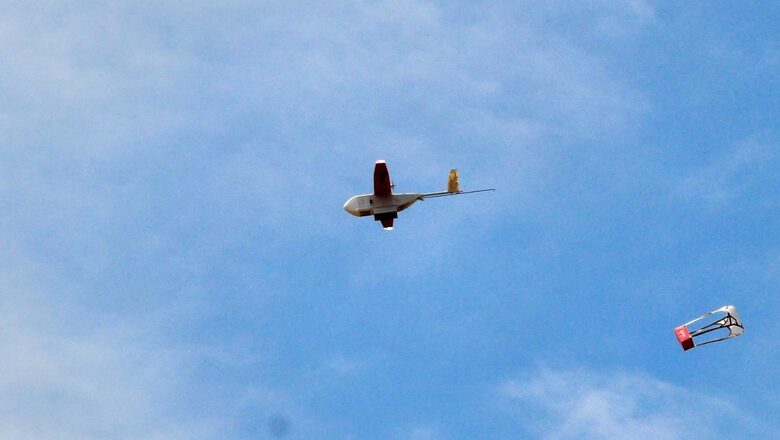
views
The government on Monday launched a revolutionary project to further inculcate drones into the Indian Healthcare system. Now, under a government initiative, drones will deliver Covid-19 vaccines in tough and hard-to-reach terrains of the Northeast regions.
Launching the initiative, Union Health Minister Mansukh Mandaviya said India is home to geographical diversities and drones can be used to deliver essentials to the last mile. An earlier project – Telangana government’s “Medicines from the Sky” for delivering medicines and Covid-19 vaccines using drones – has also proved successful. A total of 175 deliveries in a short span of 21 days have already been completed till today.
According to experts, drone-based healthcare systems play a vital role. Using drones could make delivery of critical medicines, vaccines especially to remote areas, more accessible and faster. Also, the use of drones to deliver medical supplies will help in better resource management of the limited supplies and facilitate just-in-time delivery to the current supply chain system.
Other unique projects across the world are already making use of the benefits of drones in various healthcare initiatives. Here’s a look at them:
1.) Drones are Helping Stop TB Spread in Nepal
Drones are helping stop the spread of tuberculosis in Nepal. According to the National Tuberculosis Control Centre, the bacterial infection affects about half of the population and is one of the top ten causes of death in the country.
However, some communities in the steep topography of the Himalayan country might be difficult to reach by land, leaving residents with little access to healthcare.
“Sometimes, people are forced to die due to fever, diarrhoea, or a relatively minor condition since it takes them several hours to reach a neighbouring health facility,” Uttam Pudaisaini, Executive Director of Nepal Flying Labs told the World Economic Forum.
The Flying Labs network originated in Nepal to empower local communities to use drones and has since expanded to more than 30 nations. The drones transfer test samples swiftly and safely over steep terrain, speeding up testing in remote areas and slowing disease spread.
2.) Drones Release ‘Treated’ Mosquito in Fiji, Help Fight Dengue Fever
According to the World Health Organization, the South Pacific Islands are extremely vulnerable to climate change. Severe flooding in Fiji has resulted in increased standing water that lingers for long periods of time, providing the ideal breeding environment for mosquitos that spread diseases such as Zika and dengue fever, the WEF reports.
Insecticide sprays have minimal effect on the spread of these lethal diseases. Wolbachia, a naturally occurring bacteria that lowers mosquitos’ capacity to spread some viruses, could be one option. Releasing Wolbachia-treated mosquitos into the wild could disseminate the bacteria to local mosquito populations, reducing dengue disease transmission.
However, driving around towns and villages releasing treated mosquito canisters restricts release to roadside areas, which might become inaccessible during wet seasons, the report says.
WeRobotics engineers collaborated with the World Mosquito Program to create a temperature-controlled airborne release mechanism for drones that can carry up to 160,000 Wolbachia-treated mosquitos and release 200 at 50-metre intervals. Aerial releases are significantly faster than ground releases and can cover a larger area, especially during monsoons, aiding in dengue disease prevention.
3.) Distributing HIV Medicine to Remote Parts in Africa
Transporting HIV drugs Uganda’s Kalangala District has been a tough task as the region consists of 84 islands in Lake Victoria; access to the inaccessible location in East Africa is possible only by boat. While rates of HIV infection on Uganda’s mainland have fallen over the years, rates on the islands have climbed by up to 25% annually, owing in part to political and cultural impediments to HIV prevention efforts, the firm Johnson & Johnson explains in its report.
The company is financing a programme that uses medical drones—essentially small 22-pound unmanned aircrafts—to deliver HIV drugs in the region. The drones are specifically delivering antiretroviral medications provided by Uganda’s Ministry of Health to the people of the Kalangala islands.
4.) Drones Have Been Used to Transport Donated Organs Too
Drone test flights in Nevada last year also demonstrated that they can transport organs for transplantation safely. MissionGo, a transportation logistics company, collaborated with the Nevada Donor Network on a trial flight of corneas and kidneys across the desert, the Business Insider said in a report. Experts believe organ delivery by drones is set to increase in the US.
5.) Delivering Blood to Hospitals in Rwanda
Drones are being used in Rwanda to deliver critical blood supplies to hospitals. The most common method of delivering blood is by road, which often takes too long. California firm Zipline releases drones into the air, and once there, they descend to a height of 30ft and drop the package, which floats gently to the ground thanks to a paper parachute, the BBC reports.
A new technology is saving lives in Rwanda’s most rural areas, the WHO says. Rwanda has built a high-quality national blood service over the last two decades, increasing its blood donation rates between 2000 and 2018. The employment of cutting-edge technology, such as drones to carry blood to individuals in need, has been critical to the service’s success.
Read all the Latest News , Breaking News and IPL 2022 Live Updates here.














Comments
0 comment